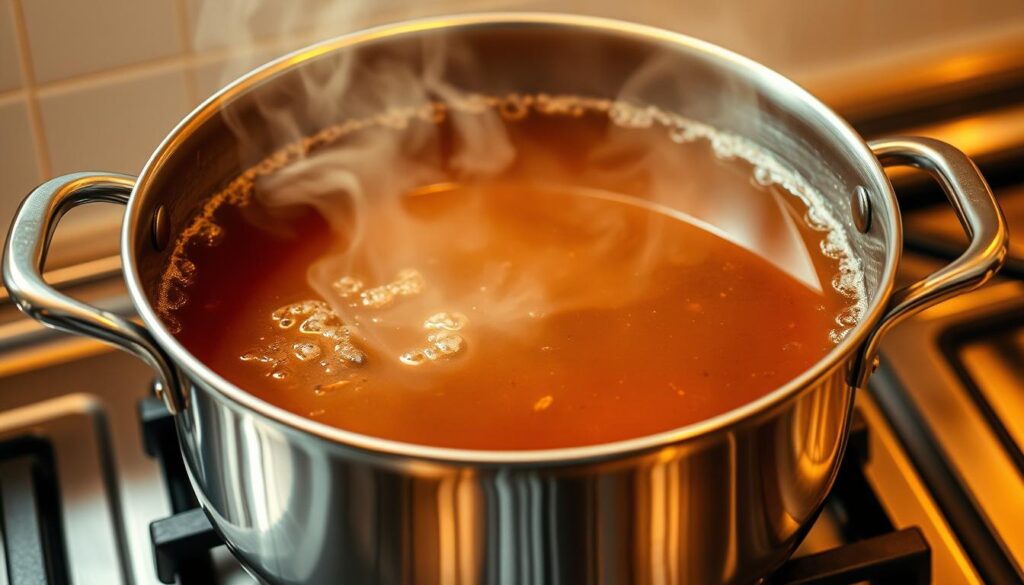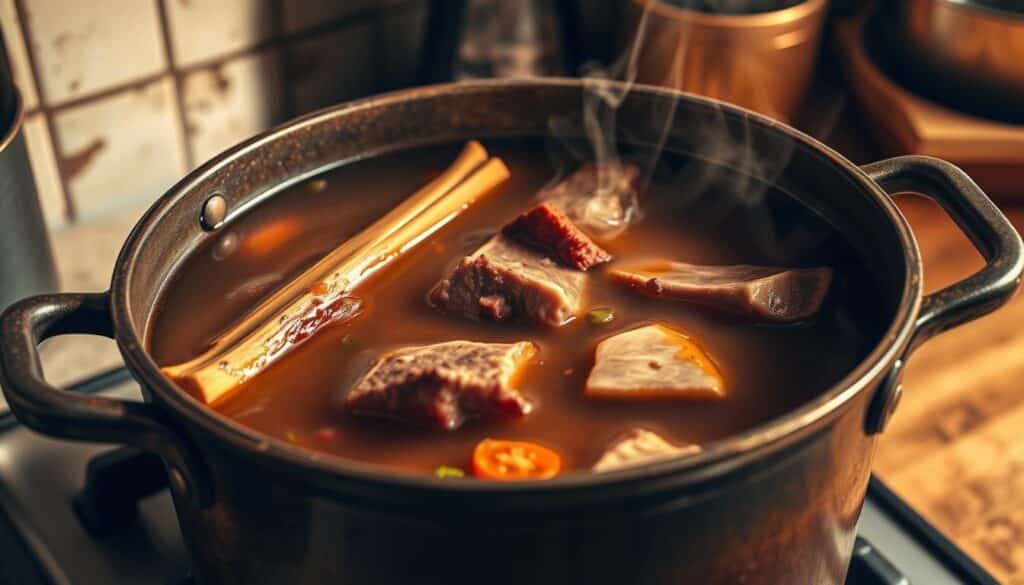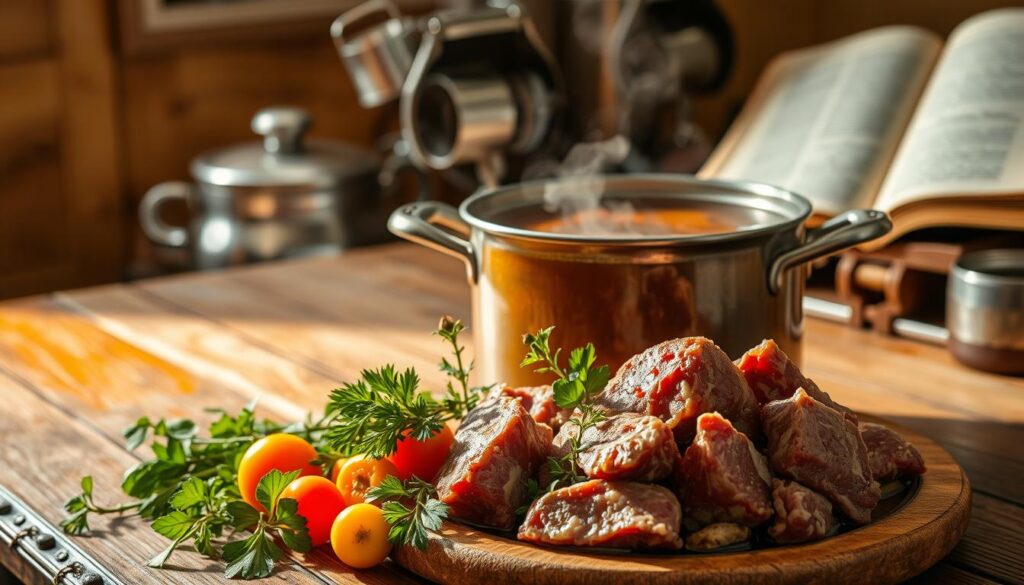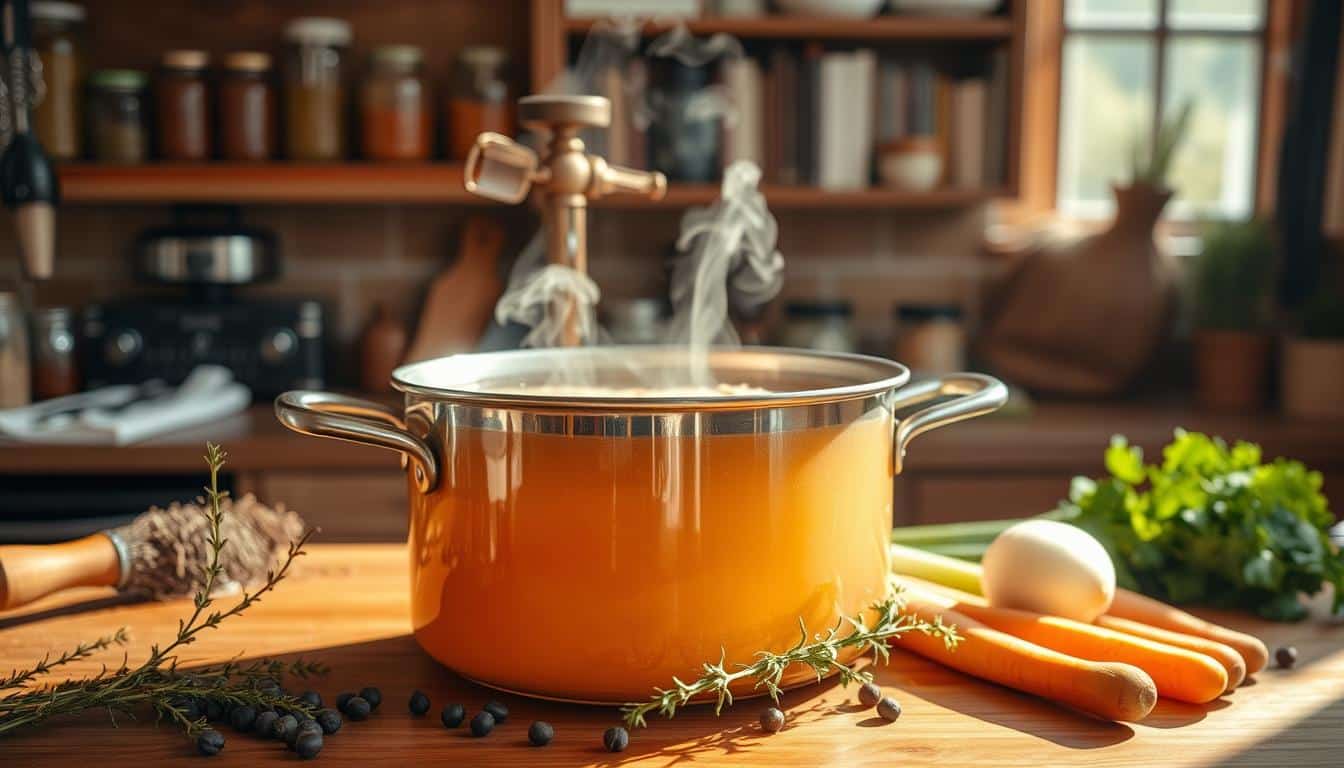Imagine making your next family meal taste like it came from a fancy restaurant. Beef broth is more than just a liquid; it’s a flavor enhancer that makes simple dishes into hits. From cheesy pasta to slow-cooked French onion soup, beef broth makes a big difference.
With 17 featured dishes, including a 4.27/5-rated quick-to-prepare pasta recipe, you’ll see how beef stock adds depth to meals. It’s a game-changer for any dish.
Think about saving time and boosting nutrition at the same time. Try 10 oz of pasta cooked in broth or a one-skillet meal ready in 20 minutes. These recipes show how beef broth can make any dish taste better and quicker.
Ready to try making Beef Stroganoff or Vietnamese pho? Beef broth is key to these dishes.
Table of Contents
Key Takeaways
- 17 recipes with beef broth featured, including 5-star cheeseburger casserole and slow-cooker favorites.
- Beef broth’s role in comfort foods: 2 cups enhance 381 kcal servings with 15g protein.
- The broth absorption method cuts prep time, using 2 tbsp butter and ⅓ cup Parmesan.
- Slow cooker recipes like Southern French onion soup (6-7 hours) dominate regional searches.
- Recipes like tailgate-friendly dishes highlight beef stock’s role in social meals.
Understanding the Rich Flavor of Beef Broth

Beef broth is known for its deep, savory taste. It’s made with roasted beef bones, vegetables, and herbs. When you make beef broth, you start by simmering it slowly. This process brings out the umami flavor.
What Makes Beef Broth Different from Other Broths
Beef broth is special because of the roasted bones. Roasting the bones at 375°F for 30 minutes makes them extra flavorful. Unlike chicken or vegetable broths, beef broth includes mirepoix and herbs like thyme or bay leaves. Adding vinegar during cooking also helps extract minerals from bones, making it taste better and more nutritious.
The Culinary Versatility of Beef Broth
Beef broth is a versatile ingredient that can be used in many ways. It’s great as a base for stews, to deglaze pans for sauces, or to braise meats. Here are some ways it can enhance your meals:
- Soups: Adds depth to classics like French onion or minestrone
- Sauces: Builds gravies or béchamel with umami complexity
- Risottos: Infuses Italian dishes with savory undertones
Beef Broth vs. Beef Stock: Key Differences
Beef stock focuses more on bones, simmered for 12+ hours to create a gelatin-rich liquid. Broth, on the other hand, uses more meat scraps and is simmered for 6–8 hours. This makes broth lighter and saltier. Broth is better for soups, while stock is great for thickening sauces and braising. Knowing the difference helps you choose the right one for your dishes.
How to Make Homemade Beef Broth from Scratch
Making how do you make beef broth requires quality ingredients and patience. Follow these steps to turn raw ingredients into a savory base for soups, stews, and sauces. Start by gathering the right ingredients and preparing your kitchen for a day-long process. This effort will reward you with a rich, umami flavor.

Ingredients for Homemade Beef Broth
Begin with 4–5 pounds of beef soup bones—knuckle, marrow, or oxtail bones are best. Add 1–2 onions (quartered), 2–3 carrots (halved), 1–2 celery ribs, and 2 garlic cloves (peeled). Include 1–2 bay leaves, 10 peppercorns, and a handful of fresh parsley stems. Use a 12- to 16-quart pot to hold all ingredients.
Step-by-Step Process
- Roast bones and vegetables: Toss bones with olive oil, season with salt, and roast at 400°F for 45 minutes until golden.
- Transfer roasted bones to a large pot. Deglaze the roasting pan with ½ cup water, scraping caramelized bits, and pour into the pot.
- Add aromatics, herbs, and 8–10 cups water. Bring to a boil, then reduce to a gentle simmer between 180–200°F.
- Cook for 4–8 hours—longer simmering (up to 10 hours) enhances depth. Strain solids through a fine mesh sieve into a clean container.
Flavor-Boosting Tips
- Acid like apple cider vinegar (2 tbsp) helps extract minerals from bones.
- Skip over-boiling—gentle simmering preserves clarity and avoids bitterness.
- Skim foam off the surface during the first hour to clarify the broth.
Cooking Beef Soup Bones
For how to cook beef soup bones, focus on even roasting and slow simmering. Make sure bones are fully submerged in water. Adjust heat to maintain a bare simmer. After straining, let the broth cool at room temperature for 1–2 hours before refrigerating or freezing. Discard solid remnants after they’ve given all their flavor.
The Best Recipes with Beef Broth for Everyday Cooking
Make your meals more exciting with recipes with beef broth that are quick and easy. Try a simple beef stock-based hamburger soup. It’s ready in under 30 minutes with ground beef, onions, garlic, and 2 cups of broth. For dinner, beef stroganoff is a great choice. Use broth instead of water to make a richer sauce, with tender beef, mushrooms, and egg noodles.

Beef and barley soup is perfect for a quick weeknight meal. It uses 4 cups of beef stock with barley and root vegetables. It’s ready in under 90 minutes, perfect for family dinners. For a quicker option, Progresso beef broth can be used in casseroles like cheeseburger casserole. It saves 20% of prep time compared to making stock from scratch.
- Beef and vegetable skillet dinner: Sauté veggies, add 1 cup broth, and simmer with cubed beef until tender. Ready in 45 minutes.
- Beef broth-infused rice: Replace water with broth when cooking rice for added depth. Try it in stuffed peppers or as a side.
- Pasta primavera: Toss pasta in a quick sauce made with ½ cup broth, olive oil, and Parmesan. Ready in 20 minutes.
Discover 35+ tested recipes with beef broth that showcase its rich flavor. For instance, a 4.96/5-rated beef stew uses 6 cups broth, 2 lbs chuck roast, and root vegetables. Each serving has 25g of protein and 444 calories, making it a nutritious choice. Leftovers can be frozen, making them even more convenient. With 65% of cooks loving broth-enhanced dishes, these recipes prove beef stock makes meals better without adding complexity.
Hearty Soups and Stews That Shine with Beef Broth
Turn simple meals into cozy classics with recipes with beef broth. This golden liquid adds depth that store-bought broths can’t. Use your homemade beef bone broth for French onion soup or Asian noodle bowls.
Classic French Onion Soup
Caramelize 10 cups of sliced onions until they’re deep golden brown. Then, simmer them with 6 cups of beef broth, a bay leaf, and thyme. Top with croutons and Gruyère cheese, then broil until bubbly. This recipe makes 6-8 servings.
Beef and Barley Soup
Start with 2 lbs of cubed beef chuck, 1 cup of pearl barley, and 8 cups of broth in a Dutch oven. Add carrots, celery, and smoked paprika. Simmer for 1.5 hours until the barley is tender. Finish with fresh parsley before serving.
Vegetable Beef Stew
| Ingredient | Quantity |
|---|---|
| Beef chuck | 2.5 lbs, cubed |
| Onions, carrots, celery | 2 cups chopped |
| Tomato paste | 3 tbsp |
| Beef broth | 3 cups |
| Potatoes and bell peppers | 4 cups diced |
| Seasonings | Kosher salt, black pepper, oregano, cayenne |
Cook this beef bone broth stew for 2 hours on low heat. If it’s too thin, thicken it with a cornstarch slurry. It keeps well in the fridge for 3 days or in the freezer for 3 months.
Asian-Inspired Beef Noodle Soups
For Vietnamese pho, simmer beef bones with star anise, cinnamon, and ginger. Serve with rice noodles, bean sprouts, and basil. Taiwanese versions add braised oxtail and soft noodles. Use your broth as the base for both.
Main Dishes Enhanced by Beef Broth
Beef broth makes simple meals taste like they’re from a fancy restaurant. Try recipes with beef broth like pot roast or beef stroganoff. These dishes get even better with slow cooking, deepening their flavors.
Risotto-style pasta cooks in broth, making it creamy without using dairy. Whether you use a Dutch oven or slow cooker, making your broth makes a big difference. Homemade broth has a richer taste than store-bought.
- Pot Roast: Braised beef in broth for 4 hours yields tender meat and savory gravy.
- Beef Stroganoff: A creamy sauce base starts with reduced broth and sour cream.
- Irish Beef Stew: Guinness-infused broth adds smoky depth to slow-cooked chunks of beef.
- Beefy Risotto: Arborio rice absorbs broth gradually for a velvety finish.
- Vegetable Beef Soup Casserole: Combines barley, carrots, and broth for hearty family portions.
Recipes like shepherd’s pie soup or Korean beef stew use broth as a base. Ground beef chili with queso topping gets richer from the broth. Making a 4-cup batch costs just $0.52, under $3 per serving.
Freezing tips: portions last 3 months in airtight containers. Pro tips: Add barley or cabbage to extend servings, but adjust broth quantities by 1–2 cups. A 4.83/5-rated soup uses frozen veggies to cut prep time by 15 minutes. Elevate dishes like beef coconut curry by simmering bones first for richer broth—this step takes 2 hours but boosts flavor significantly.
What to Do with Beef Soup Bones After Making Broth
Beef soup bones have more to offer after making broth. Use leftovers to make new meals, reducing waste and adding flavor. Here’s how to get the most out of your bones.
Extracting Marrow for Spreads and Flavoring
Roast femur bones until the marrow is soft. Then, cut them open with a knife. Scoop out the marrow and mix it with parsley, capers, and minced shallots for a tasty spread.
For an Italian twist, blend the marrow with olive oil, garlic, and lemon zest. Store these spreads in jars for up to a week.
Repurposing Cooked Meat from Bones
Scrape the meat from cooled bones and use it in different dishes. Shred it for taco fillings with salsa, or mix it with diced potatoes and bell peppers for a hash. For a savory spread, combine the meat with butter, salt, and pepper into rillettes.
Refrigerate these spreads for up to three days.
Zero-Waste Practices with Beef Bones
- Grind small bone fragments into powder and mix them into garden soil to boost calcium content.
- Bake cleaned bones into crunchy dog treats if vet-approved (avoid sharp edges).
- Pulverize bones into fine meals for flower pots—sprinkle lightly around plants.
Always chill or freeze leftover marrow and meat within two hours. Sterilize bone fragments before reuse. These methods make the most of beef soup bones, turning scraps into snacks and supplements.
International Cuisine Featuring Beef Broth
Global kitchens make recipes with beef broth into cultural icons. They turn simmered bones and spice blends into unforgettable dishes. Discover how different regions transform this base into unforgettable dishes.
Italian Risottos and Pasta Dishes
Italian traditions shine with beef broth as a base. For creamy risotto, simmer Arborio rice in rich broth. Add Parmigiano-Reggiano and rosemary for flavor.
Pasta in brodo uses thin noodles like ditalali in clear broth. Minestrone gains depth from slow-cooked bones. Pro tip: Simmer marrow bones for extra umami.
Vietnamese Pho and Southeast Asian Specialties
Pho’s complexity starts with how to cook beef soup bones for 8–10 hours. Simmer oxtail and knuckles with star anise, cinnamon, and charred onions. Serve with rice noodles, bean sprouts, and lime.
In Thailand, guay tiew nuea blends broth with braised beef. Malaysian curries use broth as a tangyai.
European Classics
French consommé clarifies broth using egg whites and herbs for a clear soup. Hungarian goulash combines beef broth with paprika and root vegetables. For Russian borscht, swap water for the broth to deepen beet flavors.
Each tradition’s technique ensures layers of flavor from bones and slow cooking.
Unexpected Ways to Use Beef Broth in Your Cooking
Try new flavors by using recipes with beef broth in different dishes. Use it as a base for risotto, replacing water with beef stock for a richer taste. Poach eggs in it for a savory twist or add its flavor to bread dough.
Here are five creative ways to use it:
- Savory Ice Cubes: Freeze broth into cubes for quick sauce enhancements or cocktail mixers.
- Cocktail Mixers: Blend into Bloody Marys or mocktails for umami depth.
- Grain Mastery: Cook quinoa or farro with broth instead of water for hearty meals.
- Baked Goods: Add to doughs for savory bread or pastry fillings.
- Vegetable Braais: Braise carrots or Brussels sprouts in broth for caramelized results.
A 2012 study in Frontiers in Neurology found bone broth may improve sleep quality. It’s a healthy addition to smoothies or lattes. Try a dairy-free avocado latte with ½ cup broth, avocado, and spices.
| Recipe | Key Ingredients | Prep Time |
|---|---|---|
| Beef Broth Risotto | 2 cups broth, ½ c. arborio rice, parmesan | 30 mins |
| Cheeseburger Casserole | 1 cup broth, ground beef, pasta, cheese | 45 mins |
| Broth-Glazed Salmon | ½ cup broth, salmon fillets, herbs | 20 mins |
| Savory Scones | 1/3 cup broth, flour, rosemary | 1 hour |
Get creative with leftover broth. Reduce it into a glaze for meats or blend into dips. With its protein-rich profile, beef stock makes everything better. Experiment and enjoy the flavors!
Health Benefits of Homemade Beef Bone Broth
Homemade beef bone broth is more than a tasty soup base. It’s full of nutrients that boost your health. It’s rich in collagen and amino acids, making it a true health treasure. Learn how this broth can improve your well-being.
Nutritional Profile and Key Nutrients
A 1-cup serving of homemade beef bone broth usually has:
| Calories | 50 |
|---|---|
| Protein | 9g |
| Sodium | 450mg |
| Potassium | 280mg |
| Collagen | Derived from bones, yielding 0.5–1.7g of glycine per cup |
It’s rich in minerals like calcium and magnesium, which are good for bones. It also has electrolytes for staying hydrated. The gelatin texture means it’s full of collagen, which is great for your skin, joints, and gut.
Potential Digestive and Joint Benefits
Research on mice shows that collagen and gelatin can make the gut lining stronger. This might help with digestive issues. A 2023 study found that collagen supplements could also help with body fat.
For your joints, the amino acids glycine and proline might help repair connective tissue. However, more human studies are needed to confirm this.
How to Maximize the Health Properties in Your Broth
To get the most nutrition from your broth, follow these tips:
- Simmer bones for 12–24 hours to extract collagen fully
- Add apple cider vinegar to leach minerals from bones
- Choose marrow-rich bones like knuckles or shanks
Don’t use store-bought broths that are cooked too fast. They often lack the amino acids found in slow-cooked broths. Making your own broth at home ensures you get the most nutrients.
Storing and Freezing Beef Broth for Future Use
Storing beef stock right keeps its flavor fresh for later. Keep it in airtight containers in the fridge for up to three days. Before freezing, remove any solid fat to avoid bad smells. Make sure to label containers with the date and any added ingredients.
- Ice cube trays for small portions (1-2 cups)
- Freezer-safe bags with 2-3 inches of headspace
- Pint or quart jars filled to 80% capacity
For long-term storage, use a pressure canner at 11 lbs pressure at sea level. Adjust to 12 lbs at 2,001-4,000 feet and 13 lbs above that. Process pints for 20 minutes, and quarts for 25 minutes. Always leave 1.5-2 inches of space in jars for expansion.
Thaw frozen broth slowly in the fridge or quickly in a water bath. If it smells bad or has mold, throw it away. Freeze leftover beef soup bones in labeled bags for future use.
Freezer bags should hold 1-8 cup portions for easy access. Stack jars upright in the freezer. Use within three months for the best taste. Always check expiration dates and storage methods to keep broth safe and flavorful.
Conclusion: Elevating Your Cooking with Beef Broth
Beef broth is key in home cooking, adding flavor to soups and stews. It’s a must in French Onion Soup and Vietnamese Pho, showing its global appeal. Whether you make it from scratch or use store-bought, it brings nutrients and depth to dishes.
The broth is more than just for soups. It’s good for your joints and digestion, fitting into keto and paleo diets. Use it to cook grains, braise meats, or drizzle over veggies. Start with quality ingredients like grass-fed bones and apple cider vinegar for extra minerals.
Try beef broth in risotto or ramen for a twist. Even small batches can be frozen for up to six months. Every 2 tablespoons add flavor without extra calories. Beef broth is versatile, making any meal better, one pot at a time.

